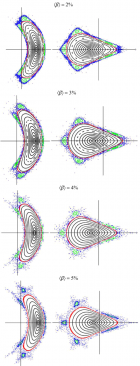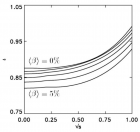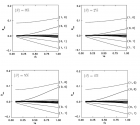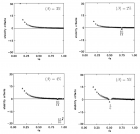Abstract
Research Article
Magnetohydrodynamic (MHD) stability of wendelstein7-X reactor with resistive wall (RWMs)
Ali Pazirandeh* and Mehrnaz Sadat Shariati
Published: 22 May, 2021 | Volume 4 - Issue 1 | Pages: 033-038
Plasma stability is the biggest challenge facing the nuclear fusion industry. One of the best methods of stability study is magnetohydrodynamic (MHD) equations, which has two linear and nonlinear states. Usually linear stability analysis is used to describe the MHD state, which is obtained by linearizing nonlinear equations. The reactor under study is the W7-X reactor, which is an optimal example of a stellaratoric system.
The question raised in this research is how to create suitable conditions for the formation of plasma and heat transfer produced by the melting reaction. Many efforts have been made in this direction, but still the record holder for plasma state maintenance belongs to the international ITER project and around 1000. However, IPP researchers at the Max Planck Institute in Germany (maker of the W7-X reactor) predicted that by 2020 they would produce a pulse of 30 minutes.
The numerical method is used to investigate the stability of the reactor. In this paper, boundary conditions were expressed in terms of resistance wall. With the help of the mathematical Matlab software, magnetic field values were obtained from experimental reports extracted from the Max Planck Institute for various values of β. From the values obtained, it was concluded that the appropriate field value is β = 5 according to the ideal MagnetoHydroDynamic state and the interval defined by the Max Planck Institute.
Read Full Article HTML DOI: 10.29328/journal.ijpra.1001039 Cite this Article Read Full Article PDF
Keywords:
Magnetohydrodynamic equations; W7-X reactor; Stellaratoric system; Max planck institute reports; β; Matlab
References
- Commissioning and first operation of the pulse-height analysis diagnostic on Wendelstein 7-X stellarator. EUROFUSION WPS1-CP 16. 2016; 15268.
- Klinger T. Performance and properties of the first plasmas of Wendelstein 7-X. plasma physics. Control Fusion. 2017; 59: 014018.
- Warmer F. From W7-X to a HELIAS fusion power plant: on engineering considerations for next-step stellarator devices. Fusion Engineering and Design. 2017; 9518-9517.
- Sigonficance of MHD effects in stellarator confinement. Ms- 313705 final paper. 2016.
- Han R, Zhu P, Banerjee D, Cheng S, Yan X, et al. Low-n global ideal MHD instabilities in the CFETR baseline scenario. Plasma Phys Control Fusion. 2020; 62: 085016 6.
- Ze-Yu, Li, et.al. Low-n global ideal MHD instabilities CFETR base line scenario. Nuclear Fusion. 2018; 58: 016018.
- Wolf RC, et al. Major results from the first campaign of the Wendelstein 7-X Stellarator. Nuclear Fusion. 2017; 57: 102020.
- Laqua HP. Wendelstein 7-X Team, Overview of W7-X ECRH Results in OPI-2a. 30th Joint Russian-Germany Meeting on ECRH and Gyrotrons.* Gyrotrons are the most advanced high-power sources of millimeter wavelength radiation. They have been used for many years in electron-cyclotron-wave (ECW) systems of many existing fusion installations. EPJ of Conference. 2018; 187: 01011.
- Snipes JA. Physics requirement for the ITER plasma control system. Fusion engineering and design. 2010; 85: 461-465.
- Merkel P. Linear MHD stability studies with the STARWALL code. Physics, Plasma. 2015; 1508: 04911v1.
- Rachel McAdams, Non-linear Magnetohydrodynamic instabilities in Advanced Tokomak plasma, PhD Thesis, University o York, 2014
Figures:

Figure 1

Figure 2

Figure 3

Figure 4

Figure 5

Figure 6
Similar Articles
-
Magnetohydrodynamic (MHD) stability of wendelstein7-X reactor with resistive wall (RWMs)Ali Pazirandeh*,Mehrnaz Sadat Shariati. Magnetohydrodynamic (MHD) stability of wendelstein7-X reactor with resistive wall (RWMs). . 2021 doi: 10.29328/journal.ijpra.1001039; 4: 033-038
Recently Viewed
-
Zn2+ Ions-Immune Virucidal activities for children and adults with preventions against 2019-nCoV and COVID-19 infectionTsuneo Ishida*. Zn2+ Ions-Immune Virucidal activities for children and adults with preventions against 2019-nCoV and COVID-19 infection. J Child Adult Vaccines Immunol. 2020: doi: 10.29328/journal.jcavi.1001006; 4: 006-014
-
Exophthalmos Revealing a Spheno Temporo Orbital MeningiomaHassina S*, Krichene MA, Hazil Z, Bekkar B, Hasnaoui I, Robbana L, Bardi S, Akkanour Y, Serghini L, Abdallah EL. Exophthalmos Revealing a Spheno Temporo Orbital Meningioma. Int J Clin Exp Ophthalmol. 2024: doi: 10.29328/journal.ijceo.1001055; 8: 001-003
-
Unveiling the Impostor: Pulmonary Embolism Presenting as Pneumonia: A Case Report and Literature ReviewSaahil Kumar,Karuna Sree Alwa*,Mahesh Babu Vemuri,Anumola Gandhi Ganesh Gupta,Nuthan Vallapudasu,Sunitha Geddada. Unveiling the Impostor: Pulmonary Embolism Presenting as Pneumonia: A Case Report and Literature Review. J Pulmonol Respir Res. 2025: doi: 10.29328/journal.jprr.1001065; 9: 001-005
-
The Pores of Kohn, an Overlooked Pulmonary Structure: A ReviewAboubacar Kaka*,Frederick Merchant. The Pores of Kohn, an Overlooked Pulmonary Structure: A Review. J Pulmonol Respir Res. 2024: doi: 10.29328/journal.jprr.1001063; 8: 063-068
-
Precessional Motion Emerging from Relativistic Component of External ForceJanusz Wolny, Radosław Strzałka*, Ireneusz Bugański. Precessional Motion Emerging from Relativistic Component of External Force. Int J Phys Res Appl. 2024: doi: 10.29328/journal.ijpra.1001100; 7: 148-153
Most Viewed
-
Evaluation of Biostimulants Based on Recovered Protein Hydrolysates from Animal By-products as Plant Growth EnhancersH Pérez-Aguilar*, M Lacruz-Asaro, F Arán-Ais. Evaluation of Biostimulants Based on Recovered Protein Hydrolysates from Animal By-products as Plant Growth Enhancers. J Plant Sci Phytopathol. 2023 doi: 10.29328/journal.jpsp.1001104; 7: 042-047
-
Sinonasal Myxoma Extending into the Orbit in a 4-Year Old: A Case PresentationJulian A Purrinos*, Ramzi Younis. Sinonasal Myxoma Extending into the Orbit in a 4-Year Old: A Case Presentation. Arch Case Rep. 2024 doi: 10.29328/journal.acr.1001099; 8: 075-077
-
Feasibility study of magnetic sensing for detecting single-neuron action potentialsDenis Tonini,Kai Wu,Renata Saha,Jian-Ping Wang*. Feasibility study of magnetic sensing for detecting single-neuron action potentials. Ann Biomed Sci Eng. 2022 doi: 10.29328/journal.abse.1001018; 6: 019-029
-
Physical activity can change the physiological and psychological circumstances during COVID-19 pandemic: A narrative reviewKhashayar Maroufi*. Physical activity can change the physiological and psychological circumstances during COVID-19 pandemic: A narrative review. J Sports Med Ther. 2021 doi: 10.29328/journal.jsmt.1001051; 6: 001-007
-
Pediatric Dysgerminoma: Unveiling a Rare Ovarian TumorFaten Limaiem*, Khalil Saffar, Ahmed Halouani. Pediatric Dysgerminoma: Unveiling a Rare Ovarian Tumor. Arch Case Rep. 2024 doi: 10.29328/journal.acr.1001087; 8: 010-013

HSPI: We're glad you're here. Please click "create a new Query" if you are a new visitor to our website and need further information from us.
If you are already a member of our network and need to keep track of any developments regarding a question you have already submitted, click "take me to my Query."























































































































































